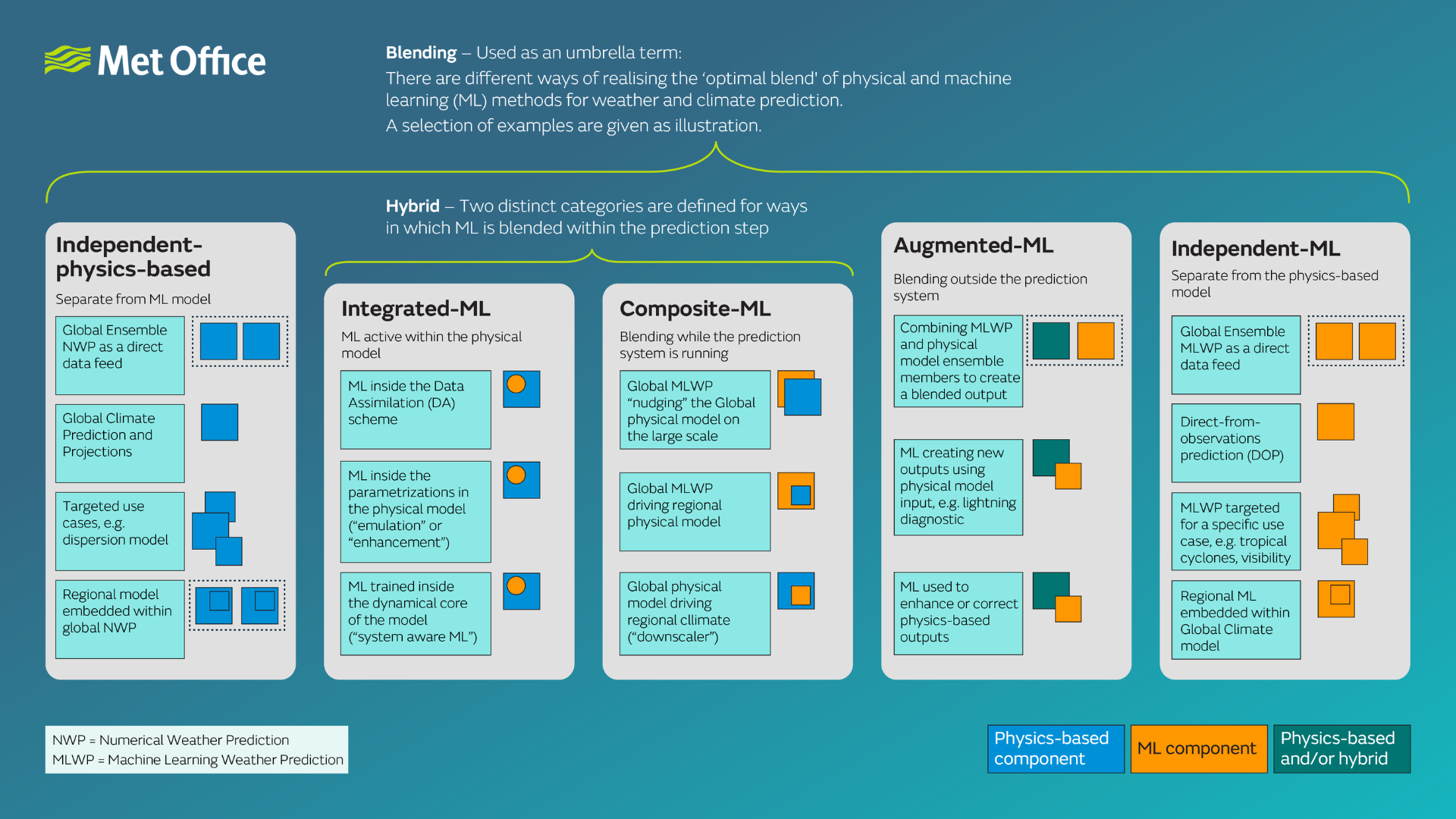Ben Shipway and Caroline Bain are Strategic Heads, leading model development teams at the Met Office. In this blog, they outline the potential future blend of AI and physics-based models, as well as steps the Met Office is taking to achieve ambitious aims.
Machine learning (ML) is a type of Artificial Intelligence and is transforming how we develop our science at the Met Office. In weather and climate prediction, it will open up new possibilities—working alongside existing physics-based models to enhance speed, accuracy, and flexibility.
We’ve recently set a clear ambition: To deliver world-leading weather and climate prediction data through an optimal blend of physics-based and ML-based modelling.
But what does that blend look like? And how do we talk about it clearly?
To help answer these questions, we’ve developed a simple framework to describe the different ways ML and physics can work together. It’s not just about technical choices—it’s about building a shared language to guide future decisions and communicate our direction to a wide range of stakeholders.
Five Ways to Blend ML and Physics
We’ve grouped the approaches into five types. Each has its own strengths, opportunities and challenges, and can be used in different parts of our prediction systems.

Independent-Physics-Based
These are the models we’ve used for decades. They simulate the Earth system using physical laws. They’re trusted and explainable. Alongside observations, the data generated by these models also underpins the training of the machine learning models that are now emerging. But they have drawbacks – such as computational cost - that the ML models do not.
Hybrid (Two Subtypes)
The term “hybrid model” has been used for some time to describe the blend of ML and physics inside our models, but it can also be used to mean different things, so we’ve split it into two clearer types:
- Hybrid-Integrated-ML
- ML is an integral part of the model—it might replace or enhance a component or process in the established physics-based system.
- Hybrid-Composite-ML
- ML and physics models run separately, with the output from one informing the evolution of the other. For example, a local physics-based model might use boundary data produced from a global ML model.
Augmented-ML
ML improves the forecast or projection after it’s made, as a post-processing step. It doesn’t change how the model runs, but enhances the value of the output. This is already being tested for blending ensemble forecasts and downscaling.
Independent-ML-Based
These are ML-only systems that make predictions without physics models. They’re fast and scalable, and often learn from physics-based data (like reanalysis datasets), which carry decades of scientific knowledge.
Each of these categories could be applied to a single prediction model, e.g. a hybrid-integrated-ML global climate model, or a modelling system, e.g. a hybrid-composite-ML ensemble forecast system.
Why This Framework Matters
This isn’t just a technical classification—it’s a strategic tool. It helps us:
- Communicate clearly about how ML and physics are being used.
- Support innovation while identifying and preserving trusted workflows.
- Design systems that match different user needs and environments.
For example:
- Hybrid and Augmented approaches allow gradual change, adding ML without losing existing physics-based knowledge and reliability.
- Independent-ML could be game-changing, but needs more work to build trust and generalisation
- Integrated and Composite hybrids offer flexibility in how ML is deployed—either within existing physics-based models or as part of a wider system.
Looking Ahead
There’s no one-size-fits-all solution. We expect a mix of approaches to emerge—tailored to different forecasting goals, computing setups, and user needs.
This framework gives meteorologists and scientists a shared starting point. It helps us talk about the “optimal blend” with clarity and confidence, as we shape the future of weather and climate prediction.
And while this blog focuses on blending strategies, it sits within a broader landscape of ML innovation at the Met Office. It reflects our commitment to combining cutting-edge technology with deep scientific expertise; to continue to improve our weather forecasts and climate projections and to carry on helping you make better decisions to stay safe and thrive.
Find out more about Met Office's approach to leveraging the benefits of AI for weather and climate intelligence.


